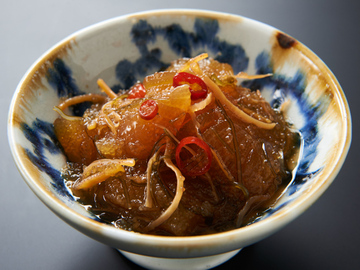Fishery fermented food

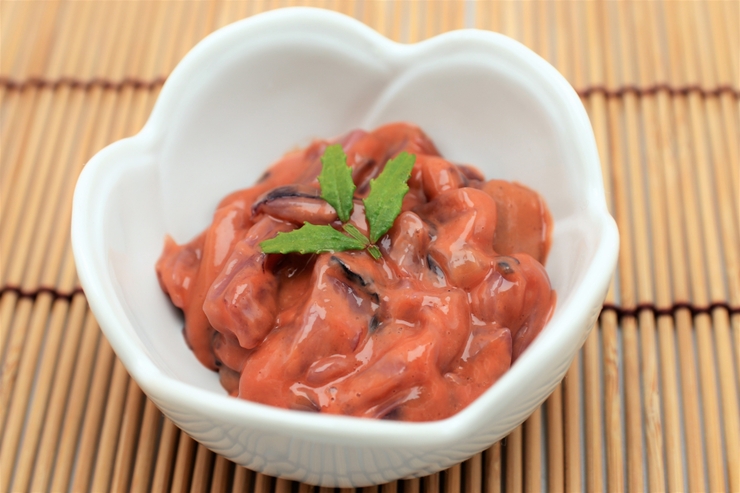
History and Culture
Japan is surrounded by the sea on all sides. Approximately as many as 4,500 fish species, both freshwater fish and saltwater fish, inhabit in the waters of Japan. With these rich fishery resources, a wide variety of food is born with regionally unique cooking styles. The technique that has nurtured such diversity is fermentation. Fermentation is a technique to preserve valuable foodstuffs and a fruit of the wisdom of our ancestors that has been refined over a long time.
It is considered that foodstuffs were pickled in salt in order to prevent them from rotting at the beginning. Then people realized the pickled fish had different tastes and flavors from the original one, which developed into various shiokara (salted and fermented fish guts) and uobishio (salted and fermented fish), and have subsequently been passed down. Though there is such description in "Konjaku Monogatari (Japanese Tales from Times Past)" compiled in the Heian era, salting is considered to have been practiced before then.
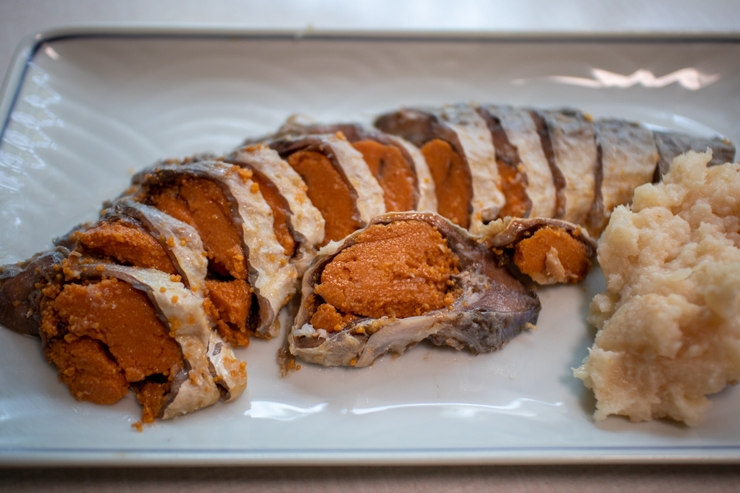
In mountain areas where fresh seafood was difficult to obtain, it was necessary to preserve it for a long time. So, the preservation technique was invented; to soak salted fish in cooked rice or rice bran to let it ferment. It is said the technique to preserve fish practiced in mountain areas in China or Southeast Asia was brought to Japan along with rice agriculture. Fermented sushi called "nare-zushi," especially popular in the Japan Sea region, is a technique that has been passed down to this day.
"Nare-zushi" is made by preserving fish stuffed with rice under a stone weight for a long time to let lactic acid fermentation occur. "Funa-zushi" is said to be the oldest form of nare-zushi and the origin of today's sushi. As time passed, a technique to speed up the fermentation process by using koji, for example, was invented. In the Genroku era, the creation of haya-zushi eliminated the need for fermentation by using cooked rice soaked with vinegar. This is the origin of nigiri-zushi today.
Characteristics and Types
Fermented fishery products are largely divided into two depending on the kinds of microorganisms involved in fermentation or production methods: salted fermented food and pickled fermented food.
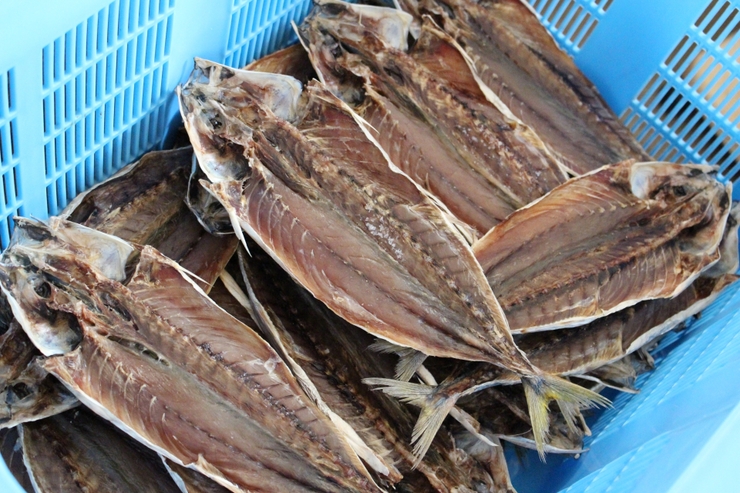
[Salted fermented food]
Representative salted fermented food include shiokara, kusaya and fish sauce (such as shottsuru and ishiru). While salt prevents fish meat or guts from rotting, digestive enzymes in fish itself act to remove fishy smells, and thus salted and fermented fish guts nurtures unique tastes. There are various kinds of shiokara in Japan, such as "shuto" using bonito guts, "konowata" using sea cucumber guts, "uruka" using sweetfish guts, "mefun" using salmon or trout guts and sea urchin shiokara, in addition to squid shiokara.
Kusaya is a fermented dried fish that is produced in the Niijima or Oshima of the Izu Islands. Japanese horse mackerel or flying fish is soaked in a fermented brine overnight and dried. Fermentation bacteria in the brine promotes antibacterial activity while generating a pungent smell.
Fish sauce is a liquid seasoning made by fermenting fish with a high-concentration of salt for one to several years. It was once widely produced in Japan, but decreased with the spread of soy sauce. Shottsuru (Akita Prefecture) and ishiru (Ishikawa Prefecture) remain today.
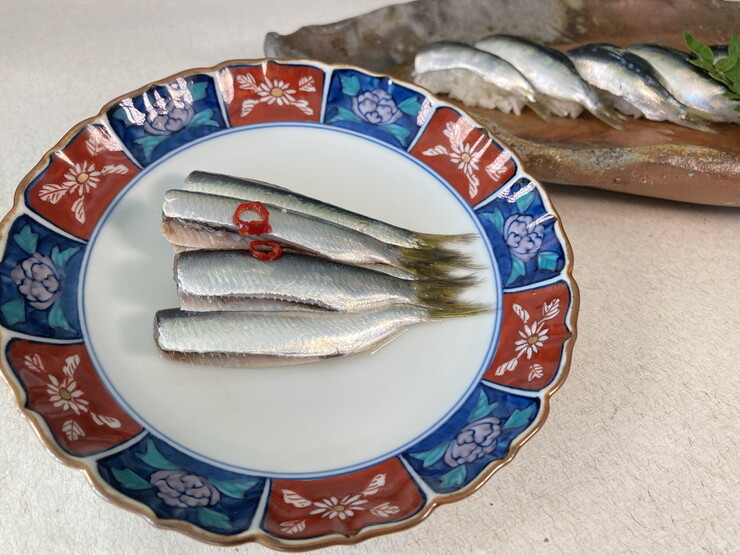
[Pickled fermented food]
Representative pickled fermented food includes nare-zushi and rice bran-pickled fish.
Among nare-zushi, "funa-zushi" in Shiga Prefecture is said to keep the oldest style. Characterized by its strong smell that is said to match kusaya, funa-zushi contains a lot of lactic acid bacteria and tastes like cheese. In addition to crucian carp, almost all fish caught in Lake Biwa such as Japanese dace and Japanese parrot fish is used for nare-zushi. A wide variety of fish species is used as an ingredient of nare-zushi including mackerel, yellowtail, salmon, herring, sailfin sandfish and sweetfish.
Rice bran-pickled fish is made by salting fish such as sardine, mackerel, herring, pufferfish and soak them in rice bran with koji to let them ferment. The well-known one is "fugu no ko nukazuke (pufferfish ovaries pickled in rice bran)" produced in Ishikawa Prefecture. Poisonous puffer fish ovaries are detoxified by fermentation of microorganisms. It takes several years to complete production.
The other pickled fish includes salted fish soaked in fermented seasoning such as vinegar or soy sauce. Fish is salted and soaked in vinegar that has an antibacterial effect and a unique flavor. Vinegar pickling is a preservation method widely practiced in Japan. Representative local dishes include "kodai no sasazuke (pickled small sea bream)" in Fukui Prefecture, "masu-zushi (pressed sushi made with salted trout)" in Toyama Prefecture and "mamakari no suzuke (Japanese shad pickled in vinegar)" in Okayama Prefecture. As a pickled seafood using soy sauce, "matsumaezuke" in Hokkaido and Tohoku region is well-known.
Production Methods
Production methods of fish sauce and nare-zushi are briefly explained.
[Shottsuru]
Fish sauce produced in Akita Prefecture. Though sailfin sandfish is well-known as an ingredient, shottsuru is made with sardine or other various fish. Salt of about 20% equal to the weight of the fish is added to let the liquid seep out from the fish. The dehydrated fish is then moved to another bucket and more salt is added. The seeped liquid is boiled and filtered, in which the fish is soaked with the weight on the top. The fish liquefies for one to several years. This liquid is filtered several times after boiling, and packed into bottles.
[Funa-zushi]
A type of nare-zushi using crucian carp caught in Lake Biwa made in Shiga Prefecture. After removing the scales, gills, air bladder and guts, the fish is stuffed with salt inside through the gill openings, packed in a bucket with a weight stone on the top and left for more than two months. Insufficient pickling in salt leaves a fishy smell. The fish is then taken out of the bucket and washed. After sun-drying for a half day or so, the fish is put in a bucket again in alternating layers with cold cooked rice and pressed with a weight. When the liquid in a bucket comes up from the bottom, fill the bucket with water in order to shield the air. It is kept for six months to two years while the water is changed occasionally.
Relationship with Regions
Fermented fishery products have been eaten across Japan. Squid shiokara is popular in Hokkaido and Tohoku region, and shuto is popular in Kochi, Shizuoka and Kagoshima where many bonitos are caught and used as the ingredient of shuto. The nare-zushi culture is mainly in the Japan Sea coast region, especially in the Hokuriku region.
Contribution to Sustainability and SDGs
Shuto that uses bonito's guts was born by using guts removed when making dried bonito. Many types of shiokara use fish guts, which also came from the wisdom of our ancestors trying to use every part of fish without wasting any. Shottsuru, one of the fish sauces, used to use sailfin sandfish that was not eaten. In this way, the Japanese have produced diverse foods without wasting the bounty of the sea and as a wisdom to preserve food for a long time. These traditional foods have a significantly modern aspect from the perspective of reducing food loss. (14. Life Below Water)
Reference
Tateo Fujii, Fumiko Konishi, Kazutoyo Kanzaki, Satoshi Mochizuki, Takeya Yoshioka, Yoshiaki Akahane, Kazuki Harada, Tatsuo Shimada, Kenichi Kawasaki, Toshihiro Yano, Masako Horikoshi, Yasuhiro Kariya, Miyoko Tamaki, Takashi Kuda, Kenichi Tsukamoto, Takahiro Kashima, Kiyofumi Nishikawa, Mayumi Mori, and Kiyomi Sato, edited by the Japanese Society of Traditional Food, "Nihon no Dento Shokuhin Jiten" [Encyclopedia of Traditional Japanese Food], Asakura Publishing Co., Ltd., p.472-533



